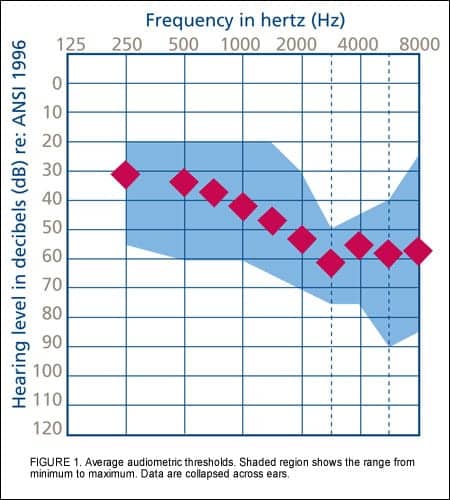|
Audible feedback is among the most prominent problems with hearing aids.1In some cases, the annoyance associated with feedback may be sufficient to negate the perceived benefits of amplification, resulting in non-use of hearing aids. The most obvious conclusion is that the whistling and buzzing associated with feedback must be minimized.
Further, a good approach to addressing feedback also improves sound quality, makes soft sounds more audible, works better on the telephone, increases speech understanding in quiet, and results in better physical fit and comfort. This is important because the overall satisfaction with hearing aids increases with the number of situations in which the listener is satisfied.2 For an overview of feedback and feedback cancellation (FBC), readers are referred to Merks et al.3
At the heart of technology advancement lies a demonstrated improvement in performance and the potential to increase benefit and/or satisfaction with hearing aids. Active Feedback Intercept (AFI), Starkey’s current-generation feedback cancellation algorithm, was developed with three primary design goals in mind:
1) Improved feedback path analysis,
2) Robust entrainment prevention, and
3) Excellent added stable gain (ASG)
To evaluate whether these design objectives were achieved, head-to-head comparisons were performed between two instruments from Starkey Laboratories: Axent II (released May 2003) and Destiny 1200 (released April 2006). While both products are equipped with feedback cancellation algorithms, only Destiny 1200 contains AFI. The outcomes of this study are described here.

Methods
Ten individuals with bilaterally symmetrical, mild to moderately severe, sensorineural hearing loss (Figure 1) participated in this study. Five of these individuals had previous research experience evaluating FBC algorithms.
Participants were fitted bilaterally with behind-the-ear (BTE) hearing aids to minimize differences in coupling to the ear as a source of variability. The devices were programmed to match the gain targets prescribed by NAL-NL1.4All advanced features unrelated to FBC— including directionality, noise management, and expansion—were turned off. The feedback cancellers were initialized and set to the adaptive mode.
A randomized cross-over design was used to ensure that all participants evaluated Destiny 1200 and Axent II, but not necessarily in that order. Further, participants were blinded to the identity and expected performance of the devices. Each pair of devices was assessed in the field for 7-10 days. Participants were asked to report the occurrence of feedback-related problems in a variety of situations. In addition, laboratory tests were conducted during each visit.
Feedback Path Analysis
Even with a feedback cancellation algorithm active, the threat of feedback remains a real possibility because the feedback path does not remain constant over time. Movements of the head and jaw, variations in insertion of the earmold into the ear canal, and the presence of objects near the hearing aid all change the characteristics of the acoustic leakage. Rapid and accurate analysis of the feedback path is associated with the reduced occurrence of feedback. During the field trials, participants reported on the prevalence of feedback during such activities as placing a telephone near the ear and facial movements (eg, smiling and jaw movements).

As shown in Figure 2, out of a total of 20 evaluations with each device, there were 8 reports of feedback with Axent II and only 2 with Destiny 1200; the light bars indicate that participants evaluated the condition but did not report feedback. Thus, feedback was four times more likely to occur with Axent II than with Destiny 1200.
Entrainment Prevention
Entrainment occurs when the FBC algorithm erroneously attempts to cancel a tonal input to the hearing aid. It is typically described as feedback after cessation of the sound, additional tones, warbling, or echoes.
Laboratory evaluation. Entrainment was evaluated in the laboratory using six stimuli known to cause this artifact: ambulence siren, car horn, choir music, pure tone at 3,000 Hz, telephone ring, and whistling. The stimuli were presented at 50 dBA through a loudspeaker placed 3 feet in front of the listener. For each stimulus, participants were asked to rate the strength of their preference for the quality of the sound in Memory 1 or Memory 2; FBC was randomly disabled in one of these memories. If necessary, the overall gain was adjusted in both memories so that feedback did not occur in either condition. Under such circumstances, the best possible performance is a rating of “no difference” between the two memories.

The mean preference ratings (Figure 3) were similar for Axent II and Destiny 1200. Further, these ratings were at or near the best possible score on the laboratory evaluation.
Field trial. During the field trials, participants evaluated five environments known to cause entrainment-like artifacts: car, vacuum cleaner, beeping sounds, music and whistling. Additional environments were also evaluated at the participants’ discretion.
Figure 4 shows that entrainment artifacts were twice as likely to occur with Axent II as with Destiny 1200. Participants described the entrainment artifacts in Axent II as an echo or a burst of feedback after the sound had stopped; the terms “pulsing” and “warbling” were used to describe entrainment artifacts in Destiny 1200.

Added Stable Gain
Added stable gain (ASG) is the amount of additional gain that can be provided without risk of feedback resulting from the use of a feedback canceller. Starting with flat, linear gain across the frequency range, the broadband gain of the hearing aid was adjusted to just below audible feedback. The real-ear aided gain (REAG) was measured for composite noise presented at 60 dBSPL. This procedure was repeated for the right and left ears, with the FBC algorithm disabled and enabled. The gain at 1,000 Hz, 1,600 Hz, and 2,500 Hz was averaged to calculate the maximum stable gain (MSG) in each condition. ASG was then computed, for both Axent II and Destiny 1200, as the difference in MSG between the FBC-off and FBC-on conditions.
Figure 5 shows the added stable gain plotted as a function of maximum stable gain in the FBC-off condition. Two key observations can be made from these data:
1) Added stable gain is greater for Destiny 1200 than for Axent II—on average, 12 dB for Destiny 1200 and 9 dB for Axent II.
2) Destiny 1200 shows a marked trend toward decreasing ASG as the MSG in the FBC-off condition increases.
This ceiling effect is the primary limitation of this clinical method of measuring maximum stable gain. That is, when the MSG is high with the feedback cancellation algorithm disabled, the maximum gain of the device is frequently reached before feedback can be elicited with the FBC algorithm enabled. A similar trend is seen in the data obtained from a previous clinical evaluation of Destiny 1200 (shown by the green triangles in Figure 5), which included both custom and BTE styles.

The fact that the Axent II data show no such trend indicates that the best possible ASG provided by the FBC algorithm is about 10 dB. By contrast, ASGs as high as 18 dB are seen with Destiny 1200 in this study.
Discussion
Feedback cancellation algorithms are a useful, and often necessary, addition to hearing aids. Directly or indirectly, they address several of the most important improvements sought by hearing instrument users, including better sound quality, less whistling and buzzing, more audibility for soft sounds, enhanced telephone performance, improved speech understanding in quiet, and better comfort of fit. A good feedback cancellation algorithm is characterized by high added stable gain, little or no entrainment artifacts, and rapid response to changes in the feedback path.
Overall, the results point to superior feedback cancellation performance for Destiny 1200 compared to Axent II. There are several key differences between the two algorithms that contribute to this outcome.
- The feedback cancellation algorithm in Destiny 1200 uses 16 independent bands to model the feedback path more accurately than the broadband approach used in Axent II.
- At an adaptation rate 10 times greater than that of Axent II, the new feedback cancellation algorithm responds rapidly to changes in the feedback path and, if feedback does occur, it is cancelled more quickly.
- Entrainment is addressed in Axent II only after it is detected; Destiny 1200 proactively prevents entrainment.
Clinical evaluation of AFI reveals that design objectives have been attained. Compared to the FBC algorithm of the previous generation, the results of this study suggest that Active Feedback Intercept (AFI) in Destiny 1200 offers:
1) Improved feedback path analysis;
2) More robust prevention of entrainment, and
3) Excellent added stable gain.
References
1. Kochkin S. MarkeTrak VI: Consumers rate improvements sought in hearing instruments. The Hearing Review. 2002;9(11): 18-22.
2. Kochkin S. MarkeTrak VI: 10-year customer satisfaction trends in the US hearing instrument market. The Hearing Review. 2002;9(10):14-25,46.
3. Merks I, Banerjee S, Trine T. Assessing the effectiveness of feedback cancellation in hearing aids. The Hearing Review. 2006;13(4): 53-54-57.
4. Dillon H. NAL-NL1: A new procedure for fitting non-linear hearing aids. Hear Jour. 1999;52(4):10-16.





